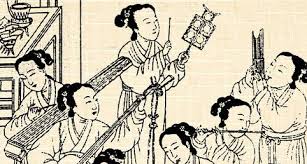The use of instruments such as the 7-string zither guqin, and the bianzhong (a set of bronze bells) necessitated the need to tune these instruments carefully and know about the relationship of pitch to each other, which formed the basis of frequency tuning in Chinese music.
Tonal Systems and the Guqin
Guqin is considered to be one of the most iconic instruments of Chinese culture that is appreciated, not only by its sound but by spiritual and intellectual symbolism. Conventionally, the guqin has a pentatonic scale, which generates five fundamental tones in an octave. String lengths and their frequencies were used in ancient China and were studied by musicians and scholars who took special care in their relationship.
Using the manipulation of the tension, length and thickness of the strings, they were able to get harmonic tones that became the model to other instruments. Guqin was also associated with the Confucian philosophy since the associated music was considered to develop goodness and inner peace.
The Bianzhong and the Development of Pitch
The bianzhong, a collection of bronze bells, of varying size and, hence, yielding different pitches, constituted yet another incredible innovation. These bells also enabled artists to experiment with such minor variations as semitones, an important innovation of early music theory.
The archaeological discovery of bianzhong in the tomb of Marquis Yi of Zeng provides a complete set of bianzhong that could date back to as early as 5th century BCE, indicating how well the ancient Chinese knew about acoustics.
These bells allowed the definite system of tonal references which impacted passing the frequency standards through the generations and recording them in the forms of documentations.
Music, Mathematics, and Philosophy
Chinese music theory was bound up with mathematics and cosmology over the centuries. An early text is the L Shi Chunqiu, which explained the derivation of musical pitches through mathematical ratios with the effect of connecting music to the laws of nature and even the creation of the universe.
To take an example, the cycle of fifths was both a musical and a philosophical token as it was also related to the concepts of balance and harmony. Such incorporation of sound with philosophy underscores how music colored the intellect of ancient China to the core.
Music and Learning Language
GoEast Mandarin focuses on the combination of learning and exploring a culture. Being a school of Chinese language, it promotes the students to immerse in traditional music as well as develop the skills of pronunciation and listening.
Such essential vocabulary as musical terms, lyrics of songs, and the names of musical instruments taught in capricious Mandarin will not only help students master vocabulary but also teach them to immerse in the cultural legacy of China. Music is a source of language to learners as well as a source of history.
Wrapping Up
Chinese musical notation has since developed to simplified number systems and modern uses of staff notation but the rules created by ancient musical instruments still reverberate in both the traditional performance and in the music education of the modern era.
Though the country is long gone, guqin and bianzhong continue to be an interesting mystery for musicians all over the world. The nature of development of frequency standards can help students to understand new awareness of the beauty and intellectualism of China musical traditions.














